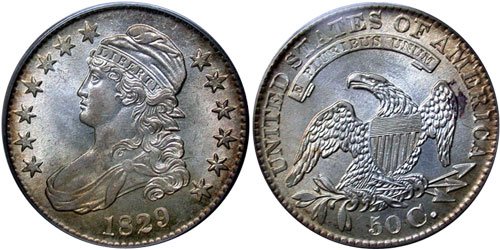Capped Bust Half Dollars
Source: My Coin Guides: Introduced in 1807, the Capped Bust Half Dollars represented the third design for the denomination. This design would be used until 1836, and in slightly modified form until 1839, before being replaced. Production for the series would be relatively high, with mintages usually extending into the millions. Silver Dollars had not been minted since 1804, making the half dollar the coin of choice for silver depositors of the era. Across the higher mintages, many different varieties were created. These die varieties are heavily collected, and as such, rare varieties can sell for remarkable premiums.

The designer of the Capped Bust Half Dollar was John Reich, an immigrant from Germany who came to the United States in the early 19th century. He was recommended by President Thomas Jefferson to become an assistant engraver at the United States Mint in 1801. However, he would not take the position until 1807 since Robert Scot, chief engraver and designer of most of the early United States coins, had refused an assistant. John Reich was eventually hired when the health and eye sight of Scot began to decline. One of Reich’s first tasks was to redesign circulating coinage, which all featured Scot’s designs.
The obverse of Reich’s new design features the bust of Liberty, facing left. She is wearing a cap, which is referred to as a Phrygian or Freedom Cap, a symbol of the American Revolutionary War. Liberty’s hair is curling and flowing gently downwards and a small part of her dress can be seen just below the neck. There are seven stars in front and six additional stars behind, representing the original thirteen states in the Union. The headband carries the inscription LIBERTY, and the date, slightly curved, is seen beneath the portrait.
The reverse of the Capped Bust Half Dollar would be featured in various forms on much of the silver coinage of the 19th century. It features an American Bald Eagle, with wings spread and a bundle of arrows and an olive branch in its claws. A scroll above the eagle includes the motto E PLURIBUS UNUM, and nearly fully around is UNITED STATES OF AMERICA. The denomination, which is expressed as 50 C., is below the eagle. Reich was the first designer who consistently included the denomination within his designs.
In 1836 Reich’s designs were replaced by slightly modified versions prepared by Christian Gobrecht. It was also at this time when the weight, diameter, and edge of the half dollar were changed. The most noticeable of the changes in design were the removal of the banner on the reverse including the motto E PLURIBUS UNUM and the update of the denomination to read 50 CENTS. In 1838 the denomination would be modified again, replaced with HALF DOL.
